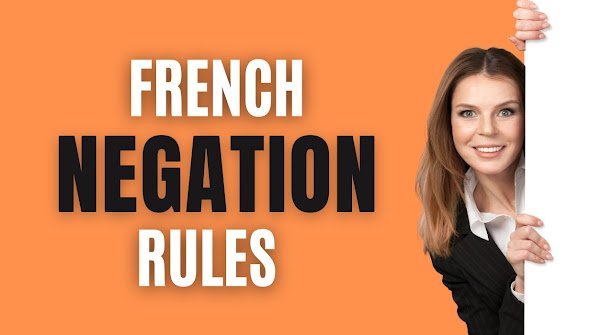The Ultimate Beginner's Guide to French Negation: Learn the Basics and Essential Structures
Introduction to French Negation
French negation can be a tricky concept for beginner French learners. However, it is essential to understand in order to correctly communicate in the language. This guide will provide you with a basic introduction to negation in French, as well as some essential structures and vocabulary to get you started.
Negatives in French is typically expressed using one of two words: ne and pas. Ne is placed before the verb, while pas follows it. For example, the negative form of the sentence "Je mange" would be "Je ne mange pas." It is important to remember that these words must agree with the subject and verb in gender and number. In other words, if the subject is plural, both ne and pas must be plural; if the verb is conjugated in the feminine form, ne and pas must also be conjugated accordingly.
There are also a few other things to keep in mind when forming negative sentences in French. First, unlike in English, French negatives are usually not compounded (e.g., we would say "I don't eat meat" rather than "I don't not eat meat"). Second, double negatives are generally avoided altogether; instead of using two negative words, it is often possible to rephrase the sentence using a positive construction.
The Basics of French Negation
In French, negation is typically done by placing ne before the verb and pas after. For example, the negative form of “I am eating” would be “Je ne mange pas”. In addition to ne and pas, other words can be used to create different types of negation.
Here are some of the most common:
Negative Adjectives
To make an adjective negative in French, simply add the word ne before it. For example, the negative form of “good” would be “ne pas bon”.
Negative Pronouns
Pronouns can also be made negative in French by adding ne before them. For example, the negative form of “I” would be “je ne suis pas” and the negative form of “you” would be “tu n’es pas”. There are many different pronouns in French, so it is important to know which one to use in each situation.
Negative Commands
Commands are typically made negative by adding ne before the verb and pas after. However, there are some irregular verbs that follow a different pattern. For example, the negative form of “venir” (to come) is actually “ne viens pas” instead of *“je ne viens pas”*.
Common Structures in French Negation
In French, there are two main types of negation: simple negation and compound negation. Simple negation is when you use the word "non" (pronounced like "naw") to negate a verb, adjective, or noun. For example:
Je n'aime pas les chiens. (I don't like dogs.)
Elle est petite. (She is small.)
Compound negation happens when you need to use both the word "non" and another negative word, such as "pas", "plus", or "jamais". The word "pas" is probably the most common negative word in French. It is used to negate verbs, adjectives, and adverbs. For example:
- Je ne mange pas de fromage. (I don't eat cheese.)
- Il n'est jamais venu en France. (He has never been to France.)
- Plus and jamais are generally used to emphasize the intensity of the negation. For example:
- Je ne mangerai plus jamais de fromage! (I will never eat cheese again!)
Essential Rules to Remember for French Negation
In French, negation is typically done by placing the word "ne" before the verb and "pas" after. For example, the sentence "Je mange du pain" would become "Je ne mange pas de pain" when negated. However, there are a few other rules to keep in mind when using negation in French.
First, when there are two verbs in a sentence, the negative word "ne" goes before the first verb and "pas" after the second verb. For example, the sentence "Je veux manger du pain" would become "Je ne veux pas manger de pain."
Second, when using an infinitive verb after another verb, the negative word "ne" goes before the first verb and "pas" stays after the infinitive verb. For example, the sentence "Je peux manger du pain" would become "Je ne peux pas manger de pain."
If you want to emphasize the negative statement even more, you can place the word "pas" twice - once before the negative word "ne" and once after. For example, the sentence "Je ne veux pas manger de pain" would become "Je ne veux pas ne pas manger de pain." This may seem like a mouthful, but it's actually not too difficult once you get used to it.
Examples of Using French Negation
French negation can seem tricky at first, but it's really not that bad once you get the hang of it. Here are some examples of how to use negation in French:
-Je ne suis pas fatigué. (I am not tired.)
-Tu ne manges pas assez de légumes. (You don't eat enough vegetables.)
-Nous ne sortons pas ce soir. (We're not going out tonight.)
-Vous ne prenez pas le bus. (You're not taking the bus.)
-Ils n'ont pas fait la vaisselle. (They didn't do the dishes.)
Resources for Learning French Negation
If you're just starting to learn French negation, or if you want to review the basics, there are some great resources to help you out. Here are a few of our favourites:
The Ultimate Beginner's Guide to French Negation: This guide covers all the basics of French negation, from key vocabulary to essential grammar structures. It's the perfect resource for anyone just starting out with learning French negation.
French Negative Words and Phrases: A list of common negative words and phrases in French, with English translations. This is a great resource for quickly lookup up negation vocabulary.
Negative Sentences in French: A detailed explanation of how to form negative sentences in French, with plenty of examples. This resource is perfect for anyone who wants a deeper understanding of French negation grammar.
Conclusion
Learning French negation can be tricky but it doesn't have to be overwhelming. We hope that this beginner's guide has been able to give you a good idea of what negation is and how it works in the French language, as well as providing you with some essential structures to get started. With practice and patience, soon enough you'll be able to confidently use French negation like a pro!




Comments
Post a Comment